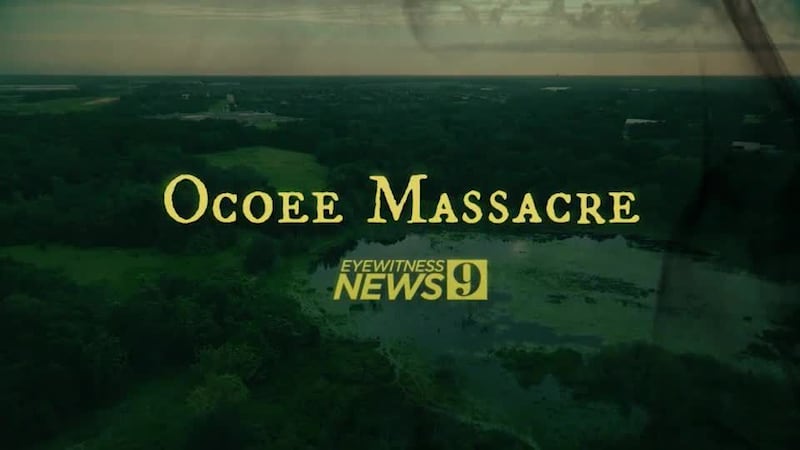OCOEE, Fla. — Jack and Annie Hamiter were doing just fine, until Nov. 2, 1920.
By then, several Black families who settled and made a home in rural west Orange County had earned enough money to buy land, some more than others.
A secret letter recently uncovered provides an untold eyewitness account to the terror unleashed in Ocoee 100 years ago, when Black people tried to vote and were forced out of town. It was penned by Annie Hamiter. She and her husband, Jack, were also landowners in Ocoee.
READ: Marking 100 years since the Ocoee Massacre: Florida governor declares day of remembrance
Annie wrote her letter with a typewriter, and it was shipped in an orange crate from the Port of Sanford.
Florida was attractive to early settlers because of its vast land and the fruit of opportunity that would become a cash cow for the state’s agricultural business. The sandy soil and the climate were prime for citrus farming.
Today, the state still celebrates it as a $9 billion industry, responsible for providing jobs to nearly 76,000 Floridians, with 70% of the U.S. citrus supply coming from Florida. Globally, the only other place producing more orange juice than Florida is Brazil. Florida also leads the market in grapefruit production.
>>> Click here to read Channel 9′s full, in-depth coverage a century after the Ocoee Massacre <<<
Back in the mid-1800s, the closet shipping port was in Sanford; it made for a long commute from west Orange County during those times. Transport, became easier, though, when Florida Midland Railroad made its way to Central Florida.
Hamiter’s letter was packed with great detail, as an eyewitness account to the fire that lingered during the Ocoee Massacre.
Jack and Annie Hamiter’s great-granddaughter Jacqueline Felder is the oldest living descendant to share the family’s story, at 95 years old.
>>> Click here to watch the full Channel 9 documentary film on the Ocoee Massacre <<<
“He was a very prosperous man, that’s all I could think of. He wanted to have something and whatever he had, and I guess he was going to give it to his grandchildren if the incident had not occurred,” Felder told Channel 9 investigative reporter Daralene Jones.
Felder has since settled in Jacksonville, but remembers her time fondly visiting her great-grandparents in Central Florida.
“She (Annie Hamiter) was a kind lady and she was a Christian and she seemed to love me; even my great-grandfather, he loved me,” Felder recalled.
READ: Why we produced the Ocoee Massacre story
“I guess I was around 7 or 8 years old, he would always ask me about writing to him and I promised I was going to write; I didn’t ever write. I was sorry I didn’t,” Felder exclaims with a chuckle, as she recounts the times she and her mother would return to visit.
The trouble started for the Hamiters and 253 other Black residents on Nov. 2, 1920.
“She only talked to me one time about it. But she only told me the part that frightened her and mentally disturbed,” Felder said.
READ: The Ocoee Massacre: Fruit of the Opportunity
That letter Mrs. Hamiter wrore appeared to be about the oranges that had helped the Hamiters earn a living and buy land. But squeezed in the second paragraph she wrote, “the most wickedest happenings of a lifetime happened here … on election night.
All the homes and some of the people were burned, one man was shot and killed and carried to the county seat and hung up as lynched.”
Felder, picks up the ghastly details from there.
READ: The Ocoee Massacre: None of Them Tried to Stay
“Someone told her that if she did not sell her property and get out of town she would be killed,” Felder said.
Felder isn’t sure if her ancestors had tried to vote. But she is certain they left in the night and abandoned their land for Winter Garden. They left five properties spread across 12-and-a-half acres of land, according to the Orange County Regional History Center.
“My mother told me that when it was time for them to escape, that they followed the threads that someone else had placed on the tree limbs and the grass,” Felder said.
READ: The Ocoee Massacre: Stolen Land
Florida Agricultural and Mechanical University law professor Leroy Pernell watched the Eyewitness News Ocoee Massacre documentary.
“I think one of the major issues to come out of Ocoee Massacre is the subsequent loss of property, homes and businesses from a thriving African American community. We know those addresses, know where the real estate is. Reparations in the case of Ocoee is not as difficult as the issue of reparations is for broader African American community,” Professor Pernell told Jones, who was the executive producer of the film.
The city of Ocoee has finally apologized to the descendants of the massacre in a letter of their own. Though just like Hamiter’s letter written out of fear, the city’s letter buries the details, making it clear no one living today can be held responsible. Words engraved 100 years later may never be enough to expunge the emotional scars the massacre left.
READ: The Ocoee Massacre: Election Day 1920
“I took her to Ocoee once. We were in Winter Garden, and she said ‘well, let’s go to Ocoee’ and I said OK, so I drove her there. We sat there and looked a while and she said ‘Well, I better not be caught down here when it’s dark’, and I said ‘don’t worry, I’ll drive away.’ So we left Ocoee and I haven’t been back there since,” Felder said.
Although a thriving and more diverse community today, the first Black resident didn’t buy property in Ocoee again until 1976. There is a proposal that will make its way through the state legislature next year to push for a form of reparations through scholarships and grants for Black people who live in Ocoee now.








